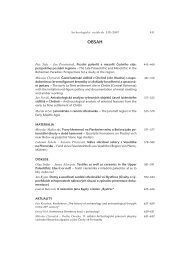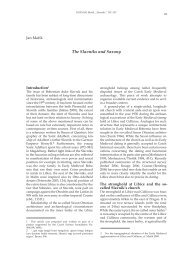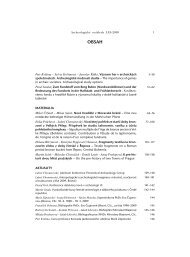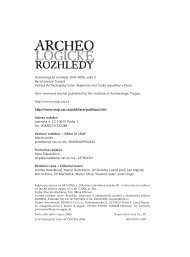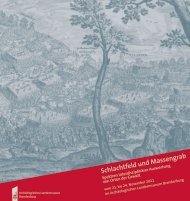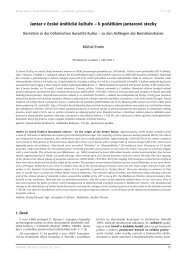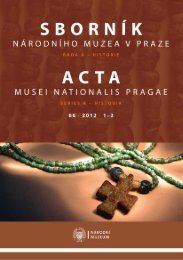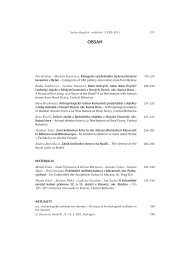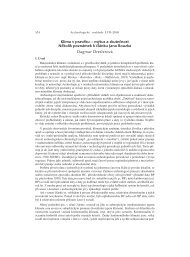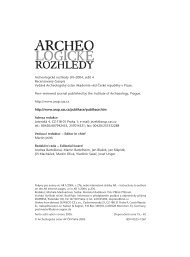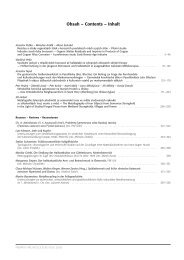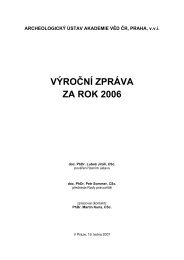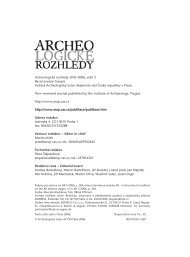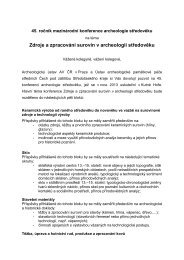Archeologické rozhledy LX–<strong>2008</strong> 343Storey, R. 2007: An elusive paleodemography? A comparison of two methods for estimating the adult agedistribution of deaths at Late Classic Copan, Honduras. American Journal of Physical Anthropology132, 40–47.Suchey, J. M. 1979: Problems in the aging of females using the os pubis. American Journal of PhysicalAnthropology 51, 467–470.Sullivan, A. 2004: Reconstructing relationships among mortality, status and gender at the medieval GilbertinePriory of St. Andrew, Fishergate, York. American Journal of Physical Anthropology 124, 330–345.Šlaus, M. – Pećina-Šlaus, N. – Brkić, H. 2004: Life stress on the Roman limes in continental Croatia. Homo 54,240–263Wood, J. W. – Milner, G. R. – Harpending, H. C. – Weiss, K. M. 1992: The osteological paradox. Problems ofinferring prehistoric health from skeletal samples. Current Anthropology 33, 343–370.Wright, L. E. – Yoder, C. J. 2003: Recent progress in bioarchaeology: approaches to the osteological paradox.Journal of Archaeological Research 11, 43–70.Živný, M. 2003: Demografie moravských pohřebišť z mladší doby hradištní (950–1250). In: V. Hašek –R. Nekuda – J. Unger edd., Ve službách archeologie IV. Sborník k 75. narozeninám prof. PhDr. VladimíraNekudy, DrSc., Muzejní a vlastivědná společnost v Brně – Geodrill – <strong>Archeologický</strong> <strong>ústav</strong> S<strong>AV</strong>,Brno, 294–302.Contemporary Czech paleodemography:False hope, excessive optimism, and feasible new objectOver the last few years, some Czech and foreign studies, mostly written by young anthropologists,have dealt with paleodemographic analysis of burial sites (for example: Živný 2003; Drozdová 2005;Hrnčířová – Jarošová 2005; 2007; Jarošová – Hrnčířová 2005). Through the analysis of skeletalassemblages provided by burial sites, those papers are focused on the assessment of individual sexand age, and also on the estimation of a number of demographic indicators. The results are presentedin the form of life tables, without any discussion about the value and the reliability of the input andoutput data. The probabilities of death according to age and sex produced in those tables are the basisfor the authors to deduce the living conditions of past populations. 10-years intervals are used forthe estimation of age at death though we actually know since a long time that no method at all can givesuch an accuracy with a good reliability (for example: Jackes 2000; Chamberlain 2000). The choiceof such 10-years categories is alleged to be needed for the sake of the comparison between thosestudies and older ones, although it would have been more appropriate to question the old paleodemographicdata. Disregarding the developments of biological anthropology and paleodemography overthe last decades is a way of clinging to the distorted view of the demography of past populations thatis sometimes fixed in the mind of the general audience (life expectancy at birth around 20 years, withdeviations from 15 to 25, lack of elderly people, short life span, high mortality for women, etc.), in spiteof the fact that it is due to biased methods dating from the pioneering period of paleodemography.A demographic analysis solely based on life tables calculated from skeletal data has lately been comparedby Sellier (2007) to Lewis Carroll’s Hunting of the Snark (1876): You never catch the Snark(the actual demographic profile of a past population) but you could eventually find something else(for the Snark was a Boojum, you see), like the archaeological significance of the skeletal sample.The uncritical use of paleodemographic calculations as if they were the actual demographic dataof archaeological populations has been questioned since the early 1980’s (for example: Petersen 1975;Howell 1982) but the pessimistic conclusions about the impossibility to draw paleodemographic estimatesfrom skeletons were eventually put aside (Bocquet-Appel – Masset 1982; Buikstra – Konigsberg 1985;Piontek – Weber 1990). A milestone in the paleodemographic thought which should be read by anyonedealing with burial sites is „The Osteological Paradox“ (Wood et al. 1992). The authors show thatfair living conditions could be wrongly attributed to populations subject to effective environmentalpressure and stress because individuals would die young, that is early enough not to have time to getstress markers on their skeleton, whereas individuals under better conditions will live much older and
344BRÒÎEK: Souãasná ãeská paleodemografie: fale‰né nadûje …will have time to get the usual signs of stress and pathology that accompany senescence. That paradoxicalappearance is misleading and conclusions would be drawn in the wrong way.Contemporary paleodemography has to face three main problems which do not allow an empiricaluse of skeletal data (for example: Chamberlain 2000; Jackes 2000). The first and common point is thefrequent lack of children, mostly the younger ones including newborns and infants, on the burial sites;there is a number of reasons that may be discussed with other archaeological data: Culture, environment,taphonomy. The second problem is the low figures of many assemblages and has to be relatedto the small size of the burial sites, to taphonomy and sometimes to the excavation itself; it is thusdifficult to appreciate the representativeness of such a small sample from the whole population viewpoint.The final and most important point is the low reliability of age at death assessments. The so-called„Rostock Manifesto“ (Hoppa – Vaupel 2002) has tried to propose a way out and to show new goals anddirection for paleodemography. The following can be considered as its basic requirements: Improvingthe osteological methods to assess age at death and peculiarly questioning the quality of the referencesample (known age and sex) the method is based on; To avoid anomalous results, those methods mustrest on Bayes’theorem; The last point of the Rostock Manifesto is a proposal for estimating the mortalityprofile of the archaeological population before assessing the individual age of the skeletons.While this line of reasoning appears convincing (Paine, <strong>2008</strong>), it has not been accepted without reservations,mainly for the reason that it disregards the question of the representativeness of the skeletalsamples. If the mortality profile of the archaeological assemblage is estimated first, a primary assumptionis made that no demographic anomaly nor cultural filter is at work within the archaeologicalpopulation. The life span of individuals is adjusted in order to preserve the mortality pattern.The researchers dealing with paleodemographic analyses follow diverse approaches, falling basicallywithin two main ranges. On one side, the „optimists“ have every confidence in the reliability ofthe results about ages and demographic patterns through the calculation of life tables and they considerthe data obtained as actual facts, like the classic demography of contemporary populations. Inthe second camp, the „pessimists“ bear in mind the weaknesses of contemporary paleodemographyas outlined above, but they are themselves subdivided into two groups: The mathematically-orientedpaleodemographers believe they can solve the problems with the use of models; the „empiricists“ fromthe second subgroup, only use demographic tools in order to identify paleodemographic anomalies andto question the nature of the burial sample, for they consider that, in the strictest sense of the word,paleodemography of burial sites is beyond our reach.From the pessimists’ point of view, quantitative paleodemographic analysis of skeletons fromburial sites (especially in terms of assessing living and health conditions through the calculation oflife expectancies) is mere utopia, with respect to the accuracy and reliability of lifespan data. Nevertheless,the analysis of burial sites by biological anthropologists has to play a large part within thearchaeological interpretation. Despite the described limits, primary demographic assessments fromburial sites can provide valuable information for the reconstruction of the past (for instance: Socialfactors, homogeneity or heterogeneity of the dead in connection with burial rites, function of thelocality/settlement, peculiarities of the selection or recruitment of the buried individuals, etc.). Purebiological analyses of skeleton assemblages using special techniques and approaches (paleogenetics,biomechanics, nutritional paleobiology, residential mobility by means of stable isotopes, paleoepidemiology,etc.) are case-specific and need to take into account the estimated data of sex and age.English by Pascal SellierJAROSL<strong>AV</strong> BRŮŽEK, UMR 5199 CNRS, PACEA, Laboratoire d’Anthropologie des Populations du Passé,Université Bordeaux I, Avenue des Facultés, F-33405 TalenceKatedra antropologických a historických věd, Filozofická fakulta ZČU, Sedláčkova 38, CZ-306 14 Plzeň;j.bruzek@anthropologie.u-bordeaux1.fr
- Page 1 and 2:
Archeologické rozhledy LX-2008 185
- Page 3 and 4:
187-228Archeologické rozhledy LX-2
- Page 5 and 6:
Archeologické rozhledy LX-2008 189
- Page 7 and 8:
Archeologické rozhledy LX-2008 191
- Page 9 and 10:
Archeologické rozhledy LX-2008 193
- Page 11 and 12:
Archeologické rozhledy LX-2008 195
- Page 13 and 14:
Archeologické rozhledy LX-2008 197
- Page 15 and 16:
Archeologické rozhledy LX-2008 199
- Page 17 and 18:
Archeologické rozhledy LX-2008 201
- Page 19 and 20:
Archeologické rozhledy LX-2008 203
- Page 21 and 22:
Archeologické rozhledy LX-2008 205
- Page 23 and 24:
Archeologické rozhledy LX-2008 207
- Page 25 and 26:
Archeologické rozhledy LX-2008 209
- Page 27 and 28:
Archeologické rozhledy LX-2008 211
- Page 29 and 30:
Archeologické rozhledy LX-2008 213
- Page 31 and 32:
Archeologické rozhledy LX-2008 215
- Page 33 and 34:
Archeologické rozhledy LX-2008 217
- Page 35 and 36:
Archeologické rozhledy LX-2008 219
- Page 37 and 38:
Archeologické rozhledy LX-2008 221
- Page 39 and 40:
Archeologické rozhledy LX-2008 223
- Page 41 and 42:
Archeologické rozhledy LX-2008 225
- Page 43 and 44:
Archeologické rozhledy LX-2008 227
- Page 45 and 46:
Obr. 12b. Praha - Malá Strana. Vý
- Page 47 and 48:
230âULÍKOVÁ: Ovoce, kofiení a l
- Page 49 and 50:
232âULÍKOVÁ: Ovoce, kofiení a l
- Page 51 and 52:
234âULÍKOVÁ: Ovoce, kofiení a l
- Page 53 and 54:
236âULÍKOVÁ: Ovoce, kofiení a l
- Page 55 and 56:
238ku, Velké Británii i na Sloven
- Page 57 and 58:
240âULÍKOVÁ: Ovoce, kofiení a l
- Page 59 and 60:
242insititia var. insititia), velko
- Page 61 and 62:
244âULÍKOVÁ: Ovoce, kofiení a l
- Page 63 and 64:
246âULÍKOVÁ: Ovoce, kofiení a l
- Page 65 and 66:
248âULÍKOVÁ: Ovoce, kofiení a l
- Page 67 and 68:
250niger), třezalku tečkovanou (H
- Page 69 and 70:
252âULÍKOVÁ: Ovoce, kofiení a l
- Page 71 and 72:
254âULÍKOVÁ: Ovoce, kofiení a l
- Page 73 and 74:
256âULÍKOVÁ: Ovoce, kofiení a l
- Page 75 and 76:
258âULÍKOVÁ: Ovoce, kofiení a l
- Page 77 and 78:
260âULÍKOVÁ: Ovoce, kofiení a l
- Page 79 and 80:
Polygonum aviculare agg., rdesno pt
- Page 81 and 82:
262DOBE· -VOJTùCHOVSKÁ: ¤ivná
- Page 83 and 84:
264DOBE· -VOJTùCHOVSKÁ: ¤ivná
- Page 85 and 86:
266DOBE· -VOJTùCHOVSKÁ: ¤ivná
- Page 87 and 88:
268DOBE· -VOJTùCHOVSKÁ: ¤ivná
- Page 89 and 90:
270DOBE· -VOJTùCHOVSKÁ: ¤ivná
- Page 91 and 92:
272DOBE· -VOJTùCHOVSKÁ: ¤ivná
- Page 93 and 94:
274DOBE· -VOJTùCHOVSKÁ: ¤ivná
- Page 95 and 96:
276DOBE· -VOJTùCHOVSKÁ: ¤ivná
- Page 97 and 98:
278DOBE· -VOJTùCHOVSKÁ: ¤ivná
- Page 99 and 100:
280DOBE· -VOJTùCHOVSKÁ: ¤ivná
- Page 101 and 102:
282DOBE· -VOJTùCHOVSKÁ: ¤ivná
- Page 103 and 104:
284DOBE· -VOJTùCHOVSKÁ: ¤ivná
- Page 105 and 106:
286DOBE· -VOJTùCHOVSKÁ: ¤ivná
- Page 107 and 108:
288DOBE· -VOJTùCHOVSKÁ: ¤ivná
- Page 109 and 110:
290DOBE· -VOJTùCHOVSKÁ: ¤ivná
- Page 111 and 112: 292DOBE· -VOJTùCHOVSKÁ: ¤ivná
- Page 113 and 114: 294DOBE· -VOJTùCHOVSKÁ: ¤ivná
- Page 115 and 116: 296DOBE· -VOJTùCHOVSKÁ: ¤ivná
- Page 117 and 118: 298Archeologické rozhledy LX-2008
- Page 119 and 120: 300POPELKA: ·típaná industrie z
- Page 121 and 122: 302POPELKA: ·típaná industrie z
- Page 123 and 124: 304POKORN¯: Nález zuhelnatûlého
- Page 125 and 126: 306KYSEL¯: Nálezy obratlovcÛ z e
- Page 127 and 128: 308KYSEL¯: Nálezy obratlovcÛ z e
- Page 129 and 130: 310Archeologické rozhledy LX-2008
- Page 131 and 132: 312HO·EK - MA¤ÍK - ·ILHOVÁ: Ka
- Page 133 and 134: 314HO·EK - MA¤ÍK - ·ILHOVÁ: Ka
- Page 135 and 136: 316HO·EK - MA¤ÍK - ·ILHOVÁ: Ka
- Page 137 and 138: 318HO·EK - MA¤ÍK - ·ILHOVÁ: Ka
- Page 139 and 140: 320HO·EK - MA¤ÍK - ·ILHOVÁ: Ka
- Page 141 and 142: 322HO·EK - MA¤ÍK - ·ILHOVÁ: Ka
- Page 143 and 144: 324HO·EK - MA¤ÍK - ·ILHOVÁ: Ka
- Page 145 and 146: 326HO·EK - MA¤ÍK - ·ILHOVÁ: Ka
- Page 147 and 148: 328HO·EK - MA¤ÍK - ·ILHOVÁ: Ka
- Page 149 and 150: 330BRÒÎEK: Souãasná ãeská pal
- Page 151 and 152: 332BRÒÎEK: Souãasná ãeská pal
- Page 153 and 154: 334BRÒÎEK: Souãasná ãeská pal
- Page 155 and 156: 336BRÒÎEK: Souãasná ãeská pal
- Page 157 and 158: 338BRÒÎEK: Souãasná ãeská pal
- Page 159 and 160: 340BRÒÎEK: Souãasná ãeská pal
- Page 161: 342BRÒÎEK: Souãasná ãeská pal
- Page 165 and 166: 346Aktualityzpůsoby informace o le
- Page 167 and 168: 348AktualityODEŠLA ALENA ŠILHOVÁ
- Page 169 and 170: 350Aktuality22. Monoxyl z Čelákov
- Page 171 and 172: 352AktualityBibliografie PhDr. Petr
- Page 173 and 174: 354Nové publikaceperiodický zdroj
- Page 175 and 176: 356Nové publikaceJiž sama skladba
- Page 177 and 178: 358Nové publikaceMarkus C. Blaich:
- Page 179 and 180: 360Nové publikaceSiegmund, F. 1998
- Page 181 and 182: 362Nové publikaceovšem usnadňova
- Page 183 and 184: 364Nové publikacepozornost věnova
- Page 185 and 186: 366Nové publikaceMartin Oliva: Gra
- Page 187 and 188: 368Nové publikacetakže ojediněl
- Page 189 and 190: 370Nové publikaceliv již dalšíc
- Page 191 and 192: 372Nové publikacevých vrstev Korm
- Page 193 and 194: 374Nové publikaceců s moderními
- Page 195 and 196: 376Nové publikacez mohyly 1) šlo
- Page 197 and 198: 378Nové publikaceLiteraturaDąbrow
- Page 199: 380Anthony Harding et. al.: VELIM -



